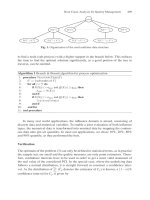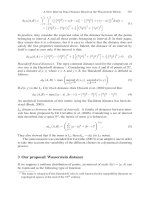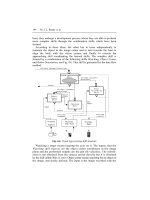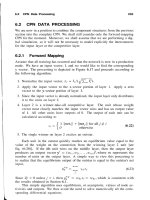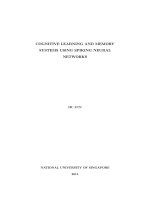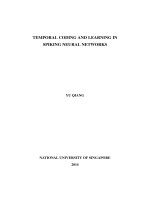Bà 7 Slide Neural Networks (machine learning)
Bạn đang xem bản rút gọn của tài liệu. Xem và tải ngay bản đầy đủ của tài liệu tại đây (4.39 MB, 50 trang )
Neural Networks
1
Neural Function
•
Brain function (thought) occurs as the result of the firing of neurons
•
Neurons connect to each other through synapses, which propagate action
potential (electrical impulses) by releasing neurotransmitters
–
Synapses can be excitatory (potential-increasing) or inhibitory (potentialdecreasing), and have varying activation thresholds
–
Learning occurs as a result of the synapses’ plasticicity: They exhibit long-term
changes in connection strength
•
There are about 1011 neurons and about 1014 synapses in the
human brain!
Based on slide by T. Finin, M. desJardins, L Getoor, R. Par
2
Biology of a Neuron
3
Brain Structure
•
Different areas of the brain have different functions
–
Some areas seem to have the same function in all humans (e.g., Broca’s region for motor
speech); the overall layout is generally consistent
–
Some areas are more plastic, and vary in their function; also, the lower-level structure
and function vary greatly
•
We don’t know how different functions are
“assigned” or acquired
–
Partly the result of the physical layout / connection to inputs (sensors) and outputs
(effectors)
–
•
Partly the result of experience (learning)
We really don’t understand how this neural structure leads to what we perceive as
“consciousness” or “thought”
4
The “One Learning Algorithm” Hypothesis
Somatosensor y
Cortex
Auditory Cortex
Auditory cortex learns to see
[Roe et al., 1992]
Somatosensory cortex learns to
see
[Metin & Frost, 1989]
Based on slide by Andrew Ng
5
Sensor Representations in the Brain
Seeing with your tongue
Human echolocation (sonar)
Haptic belt: Direction sense
Implanting a 3rd eye
[BrainPort; Welsh & Blasch, 1997; Nagel et al., 2005; Constantine-Paton & Law, 2009]
Slide by Andrew Ng
6
Comparison of computing power
INFORMATION CIRCA 2012
Computer
Human Brain
Computation Units
10-core Xeon: 109 Gates
1011 Neurons
Storage Units
109 bits RAM, 1012 bits disk
1011 neurons, 1014 synapses
Cycle time
10-9 sec
10-3 sec
Bandwidth
109 bits/sec
1014 bits/sec
•
•
Computers are way faster than neurons…
But there are a lot more neurons than we can reasonably model in modern digital
computers, and they all fire in parallel
•
•
Neural networks are designed to be massively parallel
The brain is effectively a billion times faster
7
Neural Networks
•
•
•
•
Origins: Algorithms that try to mimic the brain.
Very widely used in 80s and early 90s; popularity diminished in late 90s.
Recent resurgence: State-of-the-art technique for many applications
Artificial neural networks are not nearly as complex or intricate as the actual
brain structure
Based on slide by Andrew Ng
8
Neural networks
Output units
Hidden units Input
units
Layered feed-forward network
•
•
•
Neural networks are made up of nodes or units, connected by links
Each link has an associated weight and activation level
Each node has an input function (typically summing over weighted inputs), an
activation function, and an output
Based on slide by T. Finin, M. desJardins, L Getoor, R. Par
9
Neuron Model: Logistic Unit
2
“bias unit”
x0
x =
x0 = 1
6
4
x0
x
1
2
7
✓=
x2
x3
✓0
6
4
✓0
✓1
7
✓2
✓3
✓1
✓2
✓3
h
✓
|
(x) = g (✓ x)
1
=
1 + e—✓T x
1
Sigmoid (logistic) activation function:
Based on slide by Andrew Ng
g(z) =
1 + e—z
10
Neural Network
bias units
x0
a(2)
0
h✓(x)
Slide by Andrew Ng
Layer 1
Layer 2
Layer 3
(Input Layer)
(Hidden Layer)
(Output Layer)
11
Feed-Forward Process
•
Input layer units are set by some exterior function (think of these as sensors),
which causes their output links to be activated at the specified level
•
Working forward through the network, the input function of each unit is applied
to compute the input value
–
Usually this is just the weighted sum of the activation on the links feeding into this
node
•
The activation function transforms this input function into a final
value
–
Typically this is a nonlinear function, often a sigmoid
function corresponding to the “threshold” of that node
Based on slide by T. Finin, M. desJardins, L Getoor, R. Par
12
Neural Network
⇥(1)
⇥(2)
ai (j) = “activation” of unit i
h✓(x)
in layer j
Θ(j) = weight matrix controlling function mapping from layer j
to layer j + 1
If network has sj units in layer j and s j+1 units in layer j+1, then Θ(j) has dimension
s j+1 ×
Slide by Andrew Ng
(s j +1)
⇥(1)
.
R3⇥4
⇥(2)
R1⇥4
13
Vectorization
a
(2)
=g
1
⇥
(1)
10
x
0
+⇥
(1)
11
x
1
(1)
+⇥
12
x
2
+⇥
(1)
13
x
3
⇣
a
(2)
=g
2
⌘
⇥
(1)
20
x
0
+⇥
(1)
21
x
1
(1)
+⇥
22
x
2
+⇥
(1)
23
x
(2)
=g
3
(1)
30
x
0
+⇥
(1)
31
x
1
(1)
+⇥
32
x
2
+⇥
(1)
33
x
3
⇥
(x) = g
1
⌘
z
(2)
2
⇣
=g
⇣
h
(2)
⇣
⌘
⇥
z
=g
3
⇣
a
=g
⌘
z
(2)
3
⌘
⇥
(2)
10
a
(2)
0
+⇥
(2)
11
a
(2)
1
+⇥
(2)
12
a
(2)
2
+⇥
(2)
13
a
(2)
3
⇣
=g
z
(3)
1
h✓(x)
⇥(1)
⇥(2)
14
Based on slide by Andrew Ng
Other Network Architectures
s= [3, 3, 2, 1]
h✓(x)
Layer 1
Layer 2
Layer
Layer 4
3
L denotes the number of layers
s
+L
N
contains the numbers of nodes at each layer
–
–
Not counting bias units
Typically, s0 = d
(# input features) and s L - 1 =K
(# classes)
15
Multiple Output Units:
Pedestrian
One-vs-Rest
Car
M o torcycle
Truck
h⇥(x) 2 R
We want:
2
2
1
h
⇥
(x) ⇡
6
6
4
when pedestrian
Slide by Andrew Ng
0
7
h
⇥
(x) ⇡
6
4
0
1
2
7
h
⇥
(x) ⇡
0
6
4
0
K
2
7
h
⇥
(x) ⇡
6
4
0
0
0
0
1
0
0
0
0
1
when car
when motorcycle
7
when truck
16
Multiple Output Units:
One-vs-Rest
h⇥ (x) 2 R
We want:
2
2
1
h
⇥
(x) ⇡
6
6
4
7
0
h
⇥
(x) ⇡
6
4
0
when pedestrian
•
•
0
1
2
7
h
⇥
0
6
4
(x) ⇡
0
0
when car
K
0
2
7
h
⇥
(x) ⇡
6
4
1
0
when motorcycle
0
0
7
0
0
when truck
1
Given {( x 1 ,y 1 ), (x2,y2), ..., ( x n ,y n )}
Must convert labels to 1-of-K representation
2
– e.g.,
y
i
= 6
4
0
1
0
Based on slide by Andrew Ng
0
7
when motorcycle,
2
y
i
= 6
4
1
0
0
7
when car, etc.
17
Neural Network Classification
Given:
{( x 1 ,y1 ), (x2,y2), ..., ( x n ,y n )}
s
N
+L
s0 = d (# features)
–
Binary classification
y = 0 or 1
1 output unit (s L-1 = 1)
Slide by Andrew Ng
contains # nodes at each layer
Multi-class classification (K classes)
y 2R
K
e.g.
,
pedestrian
,
car
,
motorcycle
truck
K output units (s L-1 = K)
18
Understanding Representations
19
Representing Boolean Functions
Logistic / Sigmoid Function
Simple example: AND
g(z)
-30
+20
+20
hΘ(x) = g(-30 + 20x1 + 20x2)
Based on slide and example by Andrew Ng
h✓(x)
xx1
1
xx2
2
0
0
g(-30) ≈ 0
0
1
g(-10) ≈ 0
1
0
g(-10) ≈ 0
1
1
g(10) ≈ 1
hΘ(x)
20
Representing Boolean Functions
OR
AND
-10
-30
+20
h✓(x)
+20
h✓(x)
+20
+20
(NOT x1) AND (NOT x2)
NOT
+10
+10
h✓(x)
-20
-20
h✓(x)
-20
21
Combining Representations to Create Non-Linear
Functions
(NOT x1) AND (NOT x2)
AND
OR
-30
+10
+20
h✓(x)
+20
-10
-20
+20
h✓(x)
-20
h✓(x)
+20
not(XOR)
-10
II
I
-30
+20
+20
+10
in I
+20
in III
III
IV
-20
h✓(x)
+20
I or III
-20
Based on example by Andrew Ng
22
Layering Representations
x 1 ... x20
x21 ... x40
x41 ... x60
...
x381 ... x400
20 × 20 pixel images
d = 400
10 classes
Each image is “unrolled” into a vector x of pixel intensities
23
Layering Representations
x1
“0”
x2
“1”
x3
x4
“9”
x5
Hidden Layer
xd
Input Layer
Output Layer
Visualization of Hidden
Layer
24
Neural Network Learning
25



